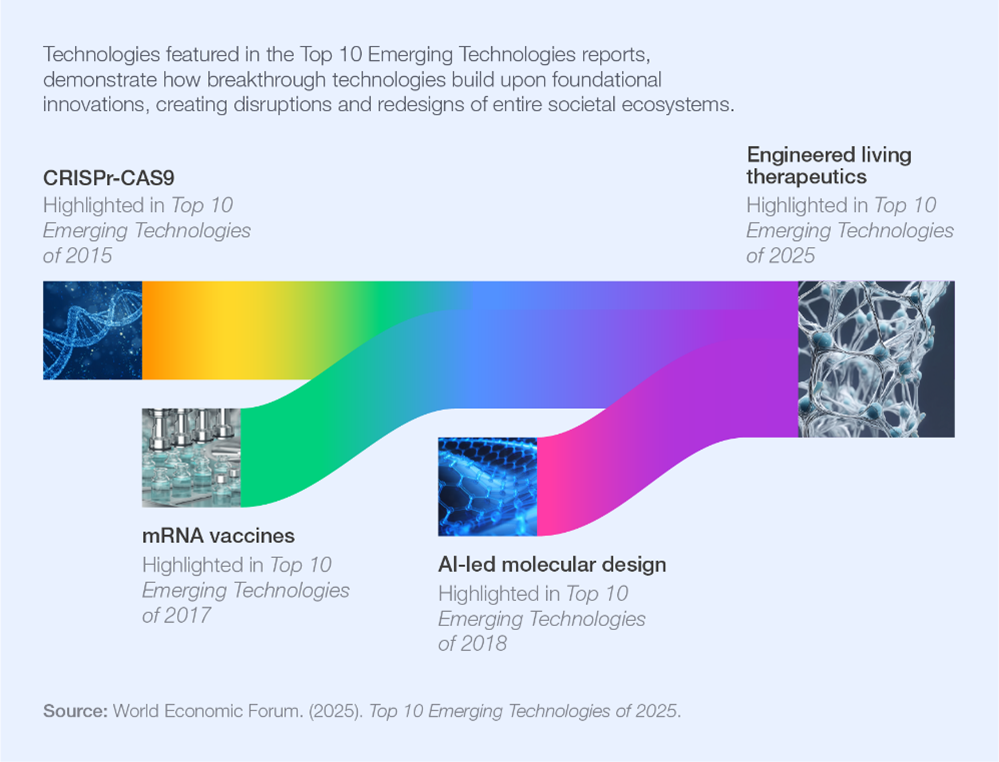- Collaborative sensing, generative watermarking and batteries built into materials are among the ten breakthrough technologies to watch.
- All are expected to achieve real-world impact within 3-5 years, addressing risks from congestion, pollution, disease and climate stress.
- Innovations reflect four emerging trends: trust and safety, sustainable industry, human health, and energy-material convergence.
- For more information on the Annual Meeting of the New Champions 2025, visit wef.ch/amnc25 and share on social media using the hashtag #amnc25, or #2025夏季达沃斯#. Read the report here.
Tianjin, People's Republic of China, 24 June 2025 - As cities become more connected, collaborative sensing is enabling vehicles, traffic systems and emergency services to coordinate in real time - improving safety and easing congestion. This is just one of the World Economic Forum's Top 10 Emerging Technologies of 2025 that is expected to deliver real-world impact within three to five years and address urgent global challenges.
In collaboration with Frontiers, the report spotlights breakthrough technologies at their inflection point where scientific progress meets real-world application. Chosen for their novelty, maturity and potential to deliver meaningful societal benefit, they reflect advances in both innovation and resilience. This year's cohort reveals four key trends: trust and safety in a connected world, next-gen biotechnologies for health, redesigning industrial sustainability, and integrating energy and materials.
"Scientific and technological breakthroughs are advancing rapidly, even as the global environment for innovation grows more complex," said Jeremy Jurgens, Managing Director, World Economic Forum. "The research provides top global leaders with a clear view of which technologies are approaching readiness, how they could solve the world's pressing problems and what's required to bring them to scale responsibly."
This year's list builds on past themes, reaffirming health, sustainability and urban resilience as top priorities. Technologies such as collaborative sensing, autonomous biochemical sensing and green nitrogen fixation demonstrate ongoing innovation in these fields where urgent challenges persist . They also signal growing momentum to develop scalable solutions to chronic disease, environmental impact and infrastructure strain.
The report outlines what is needed to bring them to scale: investment, infrastructure, standards and responsible governance, and calls on business, government and the scientific community to collaborate to ensure their development serves the public good.

This year's edition highlights a trend towards technology convergence . For example, structural battery composites combine energy with storage design, while engineered living therapeutics merge synthetic biology and precision medicine. Such integration signals a shift away from standalone innovations to more integrated systems-based solutions, reshaping what is possible.
"The path from breakthrough research to tangible societal progress depends on transparency, collaboration, and open science," said Frederick Fenter, Chief Executive Editor, Frontiers. "Together with the World Economic Forum, we have once again delivered trusted, evidence-based insights on emerging technologies that will shape a better future for all."
The Top 10 Emerging Technologies of 2025
Trust and safety in a connected world:
Networks of connected sensors can help vehicles, cities and emergency services share information in real time. This can improve safety, reduce traffic and respond faster to crises.
This technology adds invisible tags to AI-generated content, making it easier to tell what is real and what is not. It could help fight misinformation and protect trust online.
Sustainable industry redesign:
3. Green nitrogen fixation
New ways to make fertilizer using electricity instead of fossil fuels could cut pollution and carbon emissions. It also means a more sustainable way to grow food.
These lab-made materials act like natural enzymes, but are stronger, cheaper and easier to use. They could improve medical tests, clean up pollution and support safer manufacturing.
Next-generation biotechnologies for health:
5. Engineered living therapeutics
Scientists are developing new therapies using helpful bacteria that are carefully designed to deliver treatment from inside the body. This could make long-term care cheaper and more effective.
Drugs originally used for diabetes and weight loss are now showing promise in slowing diseases like Alzheimer's and Parkinson's. These treatments could offer new hope where few options exist today.
These small, smart sensors can monitor health or environmental changes around the clock without needing wires or people to check them. They could help detect pollution or illness early, saving time and lives.
Energy and material integration:
8. Structural battery composites
Materials that store energy and support weight, like in cars or planes, can make electric vehicles lighter and more efficient. This helps reduce emissions and improve performance.
By capturing energy from where saltwater meets freshwater, these systems can produce clean electricity. They are a promising source of steady, low-impact power in coastal areas.
New, smaller nuclear designs and alternative cooling systems offer safer, lower-cost clean energy. As energy demand grows with electrification and AI, these reactors could play a key role in building reliable, zero-carbon power systems.
Each technology was evaluated through a rigorous process , including expert nominations, literature review, peer assessment and analysis of adoption conditions. The report also includes strategic outlooks, readiness assessments and pathways for real-world implementation.
About the Top 10 Emerging Technologies Report
Now in its 13th edition, the Top 10 Emerging Technologies report provides trusted foresight to help leaders navigate scientific and technological change. Drawing on the expertise of scientists, researchers and futurists, the report identifies ten innovations expected to scale within five years and deliver wide societal benefits.
The 2025 report was produced in collaboration with Frontiers and selected through a global process involving over 300 experts from the World Economic Forum's Global Future Councils, the University and Research Network, the Frontiers editorial network, and co-chairs Mariette DiChristina and Bernard Meyerson.
About the Annual Meeting of the New Champions 2025
The 16th Annual Meeting of the New Champions will take place from 24 to 26 June 2025 in Tianjin, People's Republic of China, under the theme "Entrepreneurship for a New Era". The meeting will convene over 1,700 leaders from business, government, civil society, academia, international organizations, innovation and media to explore entrepreneurial solutions to global challenges.






